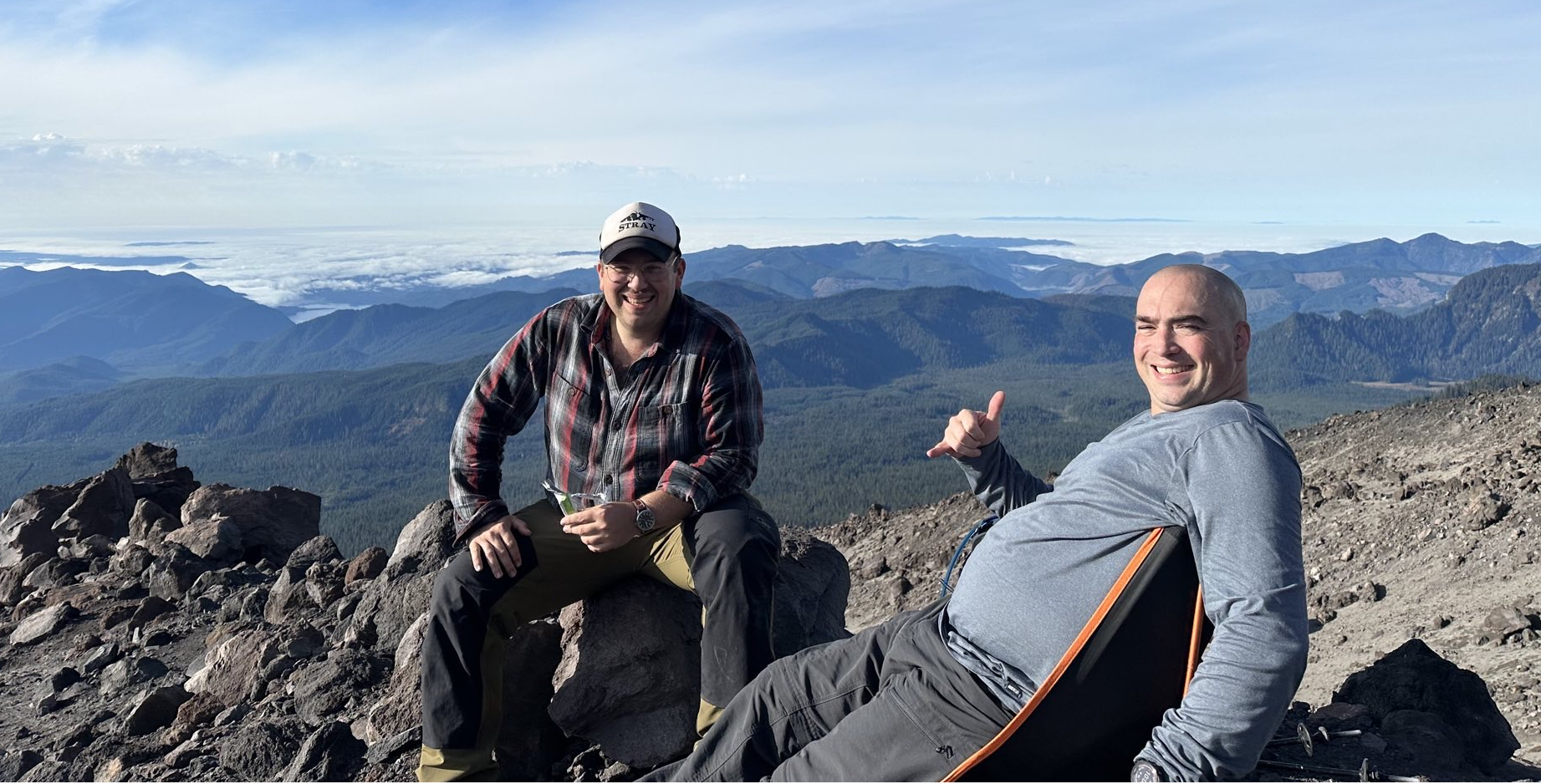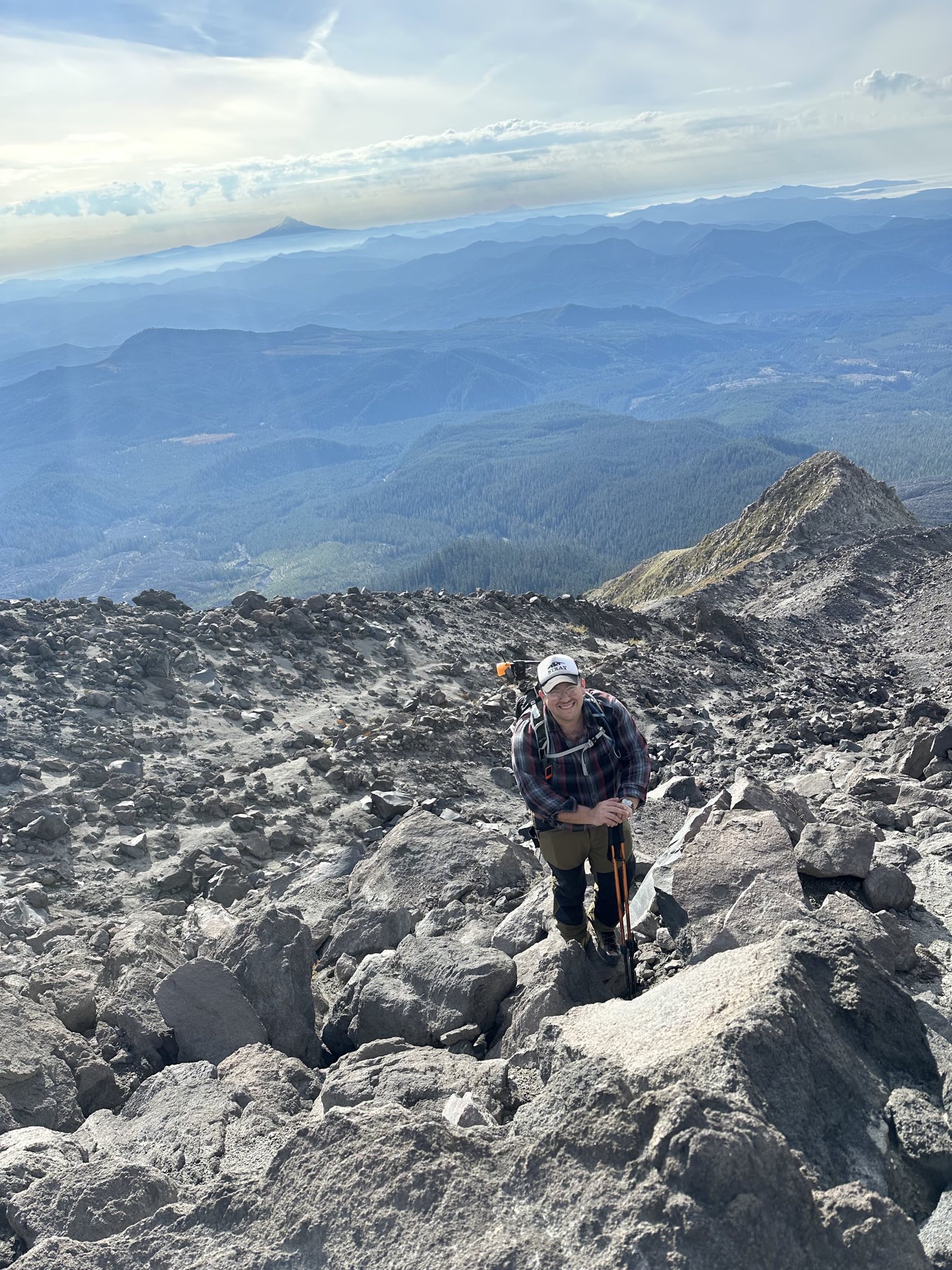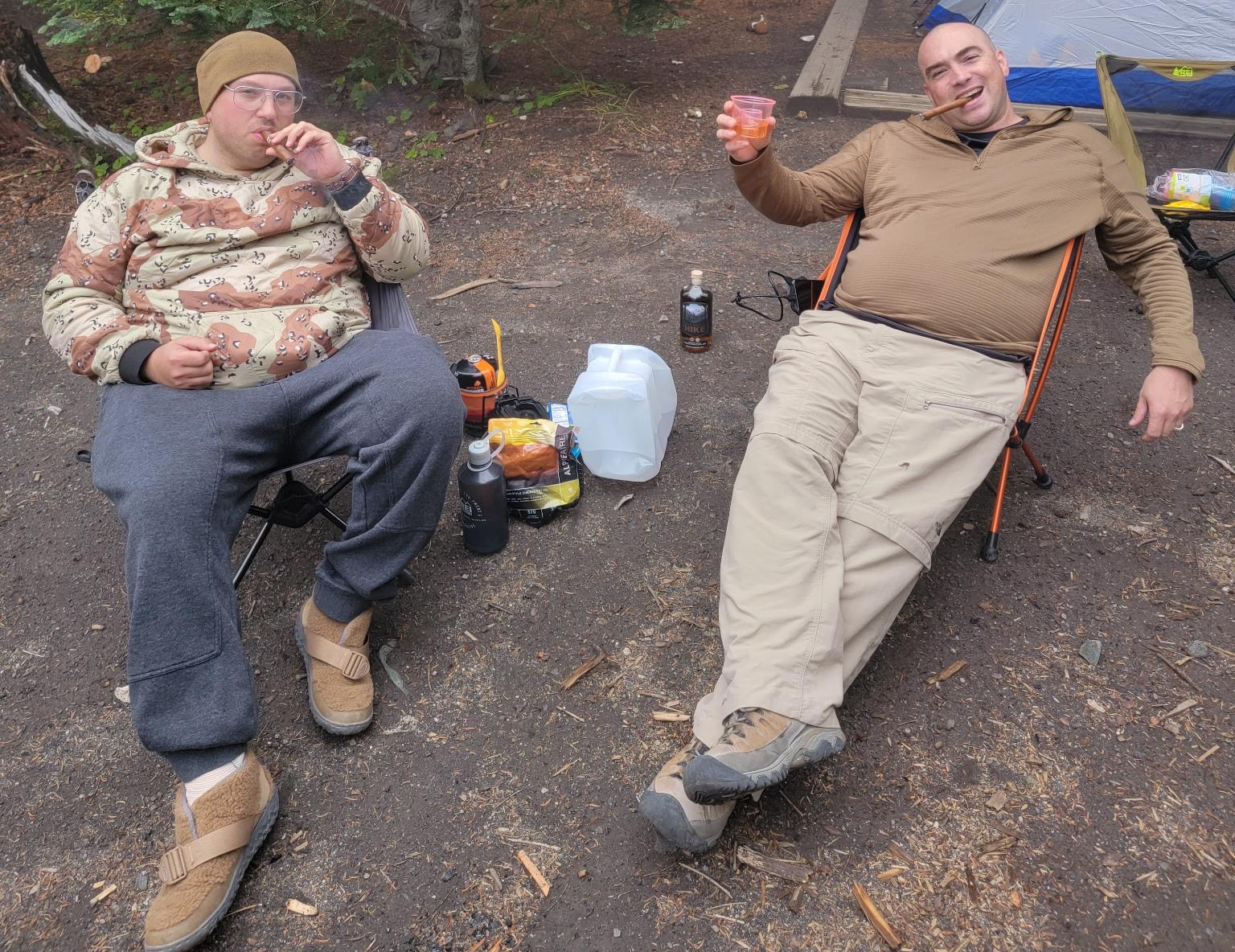The annoying beeping of my phone’s alarm disrupted my moderately satisfactory slumber. I begrudgingly looked at the phone screen; it was 3:20 AM, time to get up. I growled in distaste, having gone to bed just four hours earlier, but it was time; I needed to be on the mountain.
I rolled out of my mattress in my camper-converted Land Rover and began changing. Weatherproof pants: check; warming layer: check; sun hat: check. I slipped on my mountaineering boots and blissfully cracked open my door. The surrounding woods were draped in darkness, illuminated faintly by the stars and scattered headlights of other climbing parties around the bivouac. I clicked my headlamp on and began preparing breakfast, a delectable camping meal of biscuits and gravy, loaded with carbohydrates and fats to sustain me through the twelve-hour climb I was about to endure.
As I waited for my water to boil to pour into the dried mix that would soon be my breakfast, I continued verifying my gear. Ice axe, crampons, helmet, gaiters, additional warming layers, food, water, and a camera were all neatly crammed into a small day pack that could hardly hold a modest-sized laptop. I finalized the essentials and opened my travel humidor. The most important part of the load was four Romeo y Julieta No. 3’s, procured from my last European adventure.
Some say Cuban cigars are a mere gimmick, feverishly hyped beyond comparison due to their scarcity in the United States. To me, they signify the completion of any arduous task or milestone. The end of every work trip in austere environments, the completion of the Trans-America Trail, my Pacific Coast Highway-Route 66-Overseas Highway expedition, and every weightlifting win has been celebrated with a Cuban cigar, personally brought home by me.
I slipped the cigars and matches into a small pocket in the side of my bag and checked my gear again. It was late October, and the face of the mountain had seen snow, rain, ice, and a glaring sun, leaving me with no accurate estimates of the conditions on the face. As my climbing team finished their preparations, I checked their gear. We would be starting at 4:00 AM sharp. I performed one last check of equipment, turned my Garmin InReach, a GPS SOS system, on, and without a word, we were on the trailhead.

The low-country terrain offered a steady rise in elevation without much difficulty, only small pockets of ash as we navigated through the large fields of rock littered across the switchbacks of a revealing ridge. Our headlamps lightly caressed the various rocks as an orange and red glow emerged from the sky. The ridge revealed the silhouettes of other mountains in the range, resembling small anthills in the distance. I admired the beauty from afar as I was on a mission. In this range of giants, I, the ant, was trying to reach the top. As Lionel Terray would say, a conquistador of the useless.
I needed to lead my team to the face of the mountain by sunrise, as I wanted to utilize as much daylight as possible. The mountains tend to create their own weather. No matter how accurate the forecast is, we never truly know what she will do. The orange and yellow haze now began to erupt all around us as we navigated out of the treeline. Although faint before, the light taste of ash caressed my tongue as I sipped from my water source. For the first time, I saw the mighty face in person. The large boulders littered the face, and I gazed at it in all its glory. The eruption had happened over forty years ago, but the taste, the smell, and the aftermath were still eloquently displayed before me.
I was relieved to see that there was no visible snow throughout the visible route. This climb already required immense strength and endurance; we did not need any more factors counting against us. After conquering the first two miles of the trail, we paused to admire the sunrise around us. The glow of the sky continued to amass. The bold faces of the giants in the distance began to illuminate with their snow-capped peaks—raw, untouched beauty. There are not many words that can describe such a sight. One cannot help but feel inexplicably tiny compared to these behemoths of Earth. Yet, there I was, standing on a boulder roughly five times my size, in disbelief that I was here.
The sun rose and crested over the knife-like tip of a mountain in the east, and we opted to begin the proper climb. I looked up at the source of my physical struggles for the next several hours and gazed in a humbling manner. The rest of the route would be a scramble, a method of scaling rocks that does not qualify as technical climbing. Most scrambles do not last long and are often associated with the tail end of a climb. A scramble was necessary on this mountain for the remaining 60% of the route. I let out a sigh and sipped from my water source once more; it was going to be a long day.

I began stepping and pulling my way up the enormous masses of rock. Terray was undoubtedly correct; there is no reasonable justification for being on the mountain. There was no water, no food, just a minefield of rock and ash for the remaining 4,000 feet of elevation. The first steps of the climb hinted at the relentless nature of the ascent. With each step, I was clawing for another rock and utilizing the full extension of my legs to safely reach the next boulder. The cuts on my hands began to rack up, stinging with the trickle of sweat and mix of ash that lightly coated the open wounds.
We quickly transitioned from breaking every half mile to every 200 meters or less. Although there was no valid reward for a fast summit, I anxiously checked the weather reports at every respite, looking for any weather looming on the other side of the mountain. I remained focused on the top, trying not to look behind or below me, to avoid gaps in resolve convincing me to downclimb. I only briefly gazed during breaks to witness the mountain range become increasingly smaller, and suddenly, I found myself above the clouds. Each break, a brief glance, elevated my body and soul into a transcended state. I was in the sky, where only the birds could catch me with a less arduous ascent. It was truly remarkable.
Unfortunately, with risk also comes risk. We had been en route for nearly ten hours and were nearing the top. With less than 1,000 feet to go, all that lay ahead were about 100 yards of boulders before reaching the snow-like ash that would lead us to the summit. I heard a crackle in the rocks, “ROCK, ROCK, ROCK,” a climber shouted from above. I looked up and saw tire-sized boulders barreling toward me. I dived to the side of a red, dagger-sharp rock next to me, but it was too late. I was struck three times in the torso, leg, and ankle. I slid down to the layer of rock below me and caught myself before falling any lower. Sitting amidst the loosening rock, I carefully rolled over and took a large breath. I looked at the ridgeline below me and glazed my face with my sweaty and bloody palm. “Well, at least I’m alive,” I called to my climbing team below.
The adrenaline pulsated through my veins, giving a feeling of near-invincibility contrasted with mortality. I took a few more deep breaths, attempting to evaluate myself for injuries; I knew that with the endorphins running, it would be difficult to truly tell. I reached inside my shirt, continuing to feel for a stinging of deep breaths and movement in my ribcage, none. I caressed my thigh with both hands, feeling for any fractures; a little sore, but otherwise good. Lastly, I felt my ankle. A deep, stinging pain filled the area, and with a prior break due to an ego rock jump several years prior, I uttered my concerns.
“I messed up my ankle pretty good, but I still think I can downclimb,” I told my team, who now joined me on the ridge. I knew the next part was going to be painful. I dug my hiking poles into the ash and lifted myself up. “That’s only mildly unpleasant,” I said laughingly, still trying to evaluate the severity of the injury. “I can down climb.”
In the outdoor community, one should be prepared and have the necessities to call for help, but one is also expected to attempt self-rescue. After all, I was only slightly injured. I was still breathing and could mostly walk, so it was good enough for me. I tightened my boots, secured my hiking poles, and looked down to the treeline. Only a three-thousand-foot downclimb followed by another 2.5 miles of trail, easy.
I then began my agonizing trek to the bivouac, each step reminding me that I was injured. I grit my teeth with every nudge of my ankle. I was able to provide myself with adequate support on the boulders that lay before me. However, the ash proved to be treacherous terrain. I consistently failed to find a point of support, and a loss of control and several feet in elevation followed every step.
“At least I don’t have to climb that,” I thought to myself as I fell for the umpteenth time. With each painful shoeprint, another foot of elevation was lost on the treacherous mountain face. My adrenaline had since faded, and I was experiencing extreme pain.
After four grueling hours, we reached the tree line once again. I sighed a sigh of relief as all I had left was a 2.5-mile trail, which was nothing compared to what I had just experienced. The terrain, which was perceived as slightly arduous that morning, had dissipated into a simple nature walk. Yellow and blue luminescence faded as we encountered a deep, impenetrable fog. The temperature dropped immensely, and the distant howling of the wind began to echo in the forest.
I began to speed up as fast as I could. Although relatively safe now, we knew what we were going to experience. I limped quicker and faster, digging into the much softer ground with every step, looking forward to my chair, anti-inflammatories, and the desire to devour a meal.
The wind danced strongly amongst the tall branches, and we soon found ourselves in an even thicker bank of fog. Just as I thought to stop my team for a break, my now muddy boot touched the asphalt. We were back at camp.
I hurriedly rushed to my car, climbed into the cabin, and sat back in my bed. I stripped off my boots and tended to my wounds, gently wrapping my ankle with my first aid kit. I changed into dry, clean clothes and rested for a moment. Another dramatic adventure on my behalf and another cat life gone.

I shuffled out of my truck and began setting up my dinner table, and I almost forgot the CIGARS! I limped back to my car, tore open my summit bag, and pulled out the aluminum cases that housed the refined tobacco.
I tossed a cigar to each of my climbing partners and plopped on my seat while attempting to elevate my injured side. I struck a match and drew a breath as the first few puffs of the cigar were excellent. Although initially designed to be a summit cigar, I still felt it appropriate to celebrate. The lessons learned in austere environments are often harsh, painful, and unwanted by many. For myself, I welcome these experiences because of what they entail.
As I sorely leaned back in my chair, I thought about the thrilling sights many people see yearly. By no means am I anything special. Many people have seen what I saw, but many also do not even dream of trying. I whisked away the thoughts of the grandeur of nature in a cloud of smoke and minuscule droplets of condensation.
Every time there is a failure, we second guess ourselves with the what-ifs. Instead, we should focus on those gritty lessons born in defeat. Once again, we hardly ever want them, but at the end of the day, I still got to experience life above the clouds.

